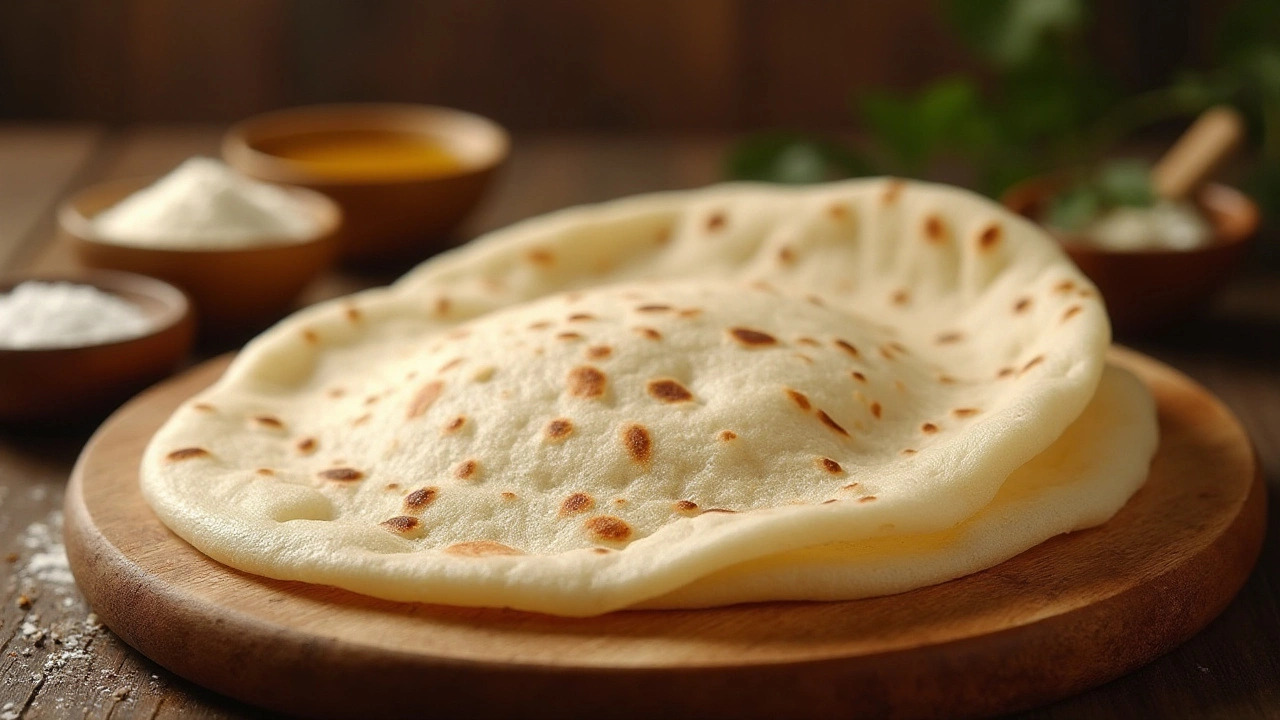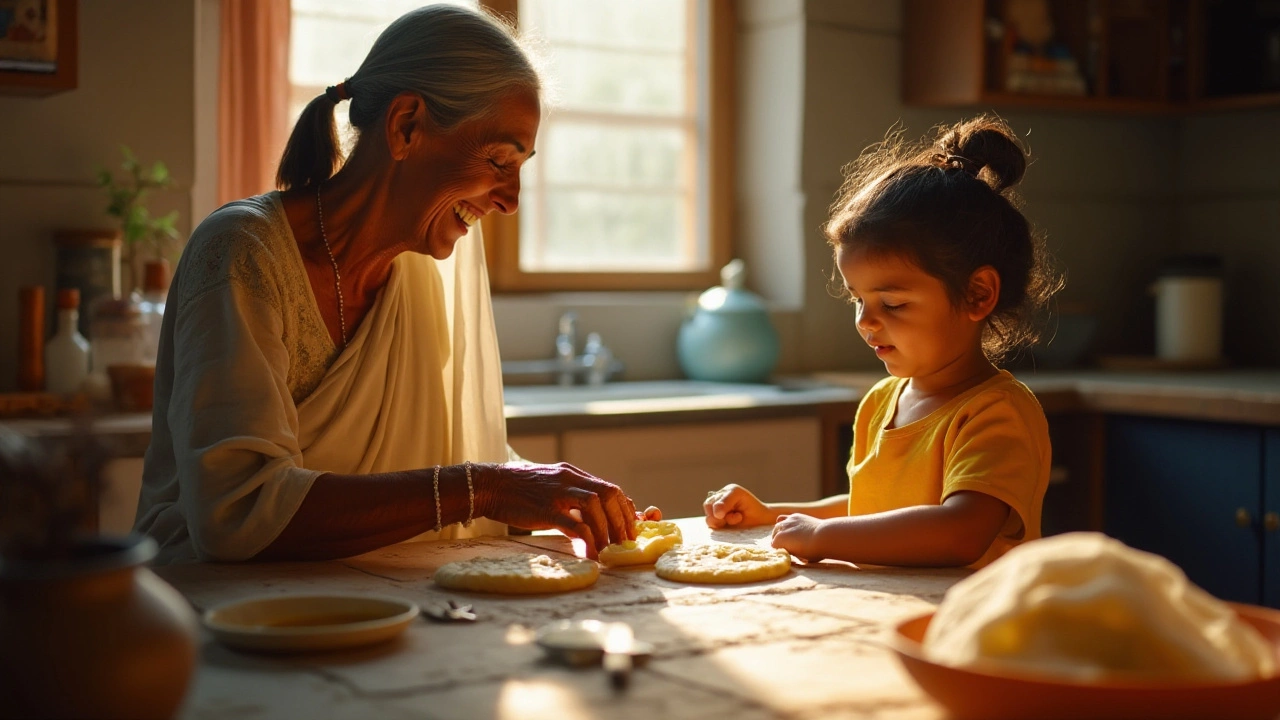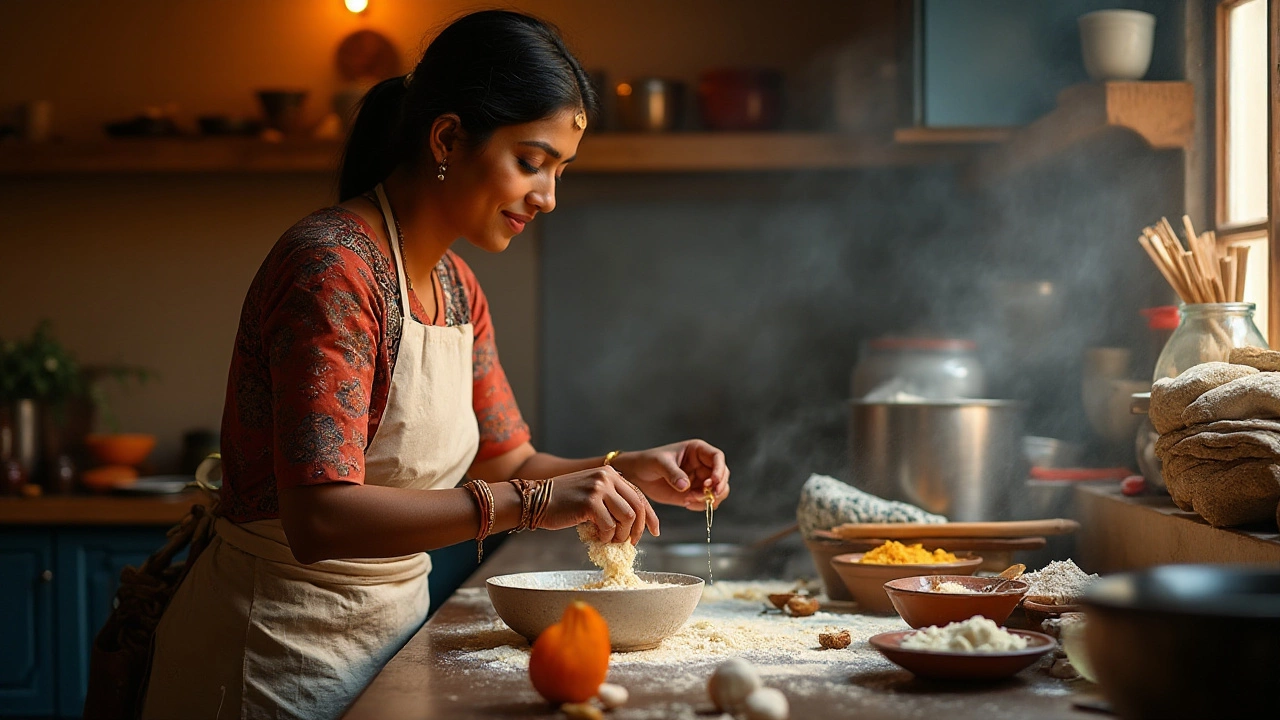4 Jan 2025
- 0 Comments
For anyone who's ventured into the delightful world of Indian cuisine, the allure of a perfectly soft roti is irresistible. This age-old flatbread, a staple in many households, serves as a canvas for curries and a vehicle for flavor.
But crafting the perfect roti, one that is both soft and pliable, requires more than just the right ingredients—it takes an understanding of each component's role. A question often arises when discussing roti making: does adding oil truly make a difference in softness?
As we explore this topic, we'll look at the humble roti through the lens of culinary science, ensuring you walk away with the knowledge to elevate your roti skills. Get ready to transform your cooking experience with tips, tricks, and the occasional surprising revelation about this beloved bread.
- Understanding the Basics of Roti
- The Role of Oil in Roti Making
- Expert Tips for Soft Rotis
- Common Mistakes and How to Avoid Them
- Alternatives to Oil for Softness
Understanding the Basics of Roti
Roti, often referred to as the heart of Indian meals, is a type of unleavened flatbread made primarily from whole wheat flour. It's a staple in many South Asian households, and its preparation is an art and science combined. Traditional roti is characterized by its soft, tender texture and slightly chewy consistency, making it a perfect accompaniment to a variety of dishes. To craft the perfect roti, it’s essential to start with high-quality wheat flour, commonly referred to as ‘atta’. This finely milled flour is enriched with bran, giving it a distinct, earthy flavor. The choice of flour can greatly affect the result, with many seasoned cooks swearing by specific brands or traditional milling techniques to achieve softness.
The process of making roti begins with preparing the dough, which consists of flour, water, and a pinch of salt. Some recipes call for a teaspoon of oil or ghee to enhance elasticity and flavor. Kneading the dough plays a crucial role in developing the gluten, which is vital for the roti's texture. The dough should feel smooth and pliable, not sticky or too dry. Typically, the dough is left to rest for at least 30 minutes. This resting period helps in relaxing the gluten strands, thereby making the rolling out process easier and more forgiving. It is during this stage that many cooks might consider adjusting the dough’s moisture level to ensure softness once cooked. Soft roti doesn't just rely on ingredients, but on technique too.
Rolling out the dough into thin, even circles is an art. It requires patience and practice. The goal is to achieve a uniform thickness without breaking or tearing the dough. A light touch with the rolling pin and rotating the dough progressively ensures even distribution. Cooking a roti requires attention to timing and temperature. Traditionally made on a flat griddle known as a ‘tawa’, the roti is cooked until it forms a few charred spots and begins to inflate with steam. The process of 'puffing' is a visual indicator of well-made roti. It’s the result of steam trapped within the layers of dough, signaling that the roti is cooked through and is going to be delightfully soft. Each of these steps might sound simple individually, but when brought together harmoniously, they culminate in the making of perfect, soft rotis.
Understanding the regional variations can deepen one’s appreciation of the roti-making process. For instance, in some Northern Indian regions, 'ghee-roti' involves smearing a layer of clarified butter post-cooking, heightening the flavor and softness. Meanwhile, in Western Indian states like Gujarat, you might encounter 'rotla', a thicker version sometimes made with millet flour. Such variations show that cultural context can influence the basic recipe while still maintaining the essence of this beloved bread. According to an article in 'The Indian Culinary Chronicles', roti not only nourishes but also connects generations through its enduring simplicity and versatility.
"Roti is more than just food; it is an expression of care and nourishment," says food historian Santosh Mehta.
The Role of Oil in Roti Making
It's intriguing how such a simple ingredient can profoundly affect the texture of your roti. The inclusion of oil in roti making isn't just about flavor—it's a game-changer for achieving that much-desired softness. When you knead oil into the dough, it acts as a shortening agent, creating a barrier around the proteins in the flour, thus limiting gluten development. This is crucial as excessive gluten can make the dough tough, impacting the tenderness of the final roti. Oil, essentially, helps structure the dough in a way that each layer of the roti remains distinct and flaky, rather than chewy and dense.
Let's explore the science a bit deeper. Oil works by coating the flour particles, minimizing their interaction with water and therefore gluten formation. This makes the dough smoother and less elastic, which means it won't spring back too much when you roll it out, allowing it to stay thin and pliable. The type of oil used can also influence the outcome. Vegetable oils like canola or sunflower oil are popular choices due to their neutral flavor, but some might prefer the nutty taste of sesame oil or the richness of ghee. Each variety brings a unique element to the table, balancing taste and texture according to personal preference.
Some seasoned cooks believe that too much oil can have a counterproductive effect, rendering the dough greasy and unmanageable. It's about finding that sweet spot in ratio—usually, a few tablespoons per cup of flour. However, don't take our word for it alone. As noted in the culinary wisdom of Anjum Anand, a respected Indian chef, "A modest amount of fat coats the flour and results in softer, evenly cooked rotis."
- Anjum AnandThe impact of oil in roti making is undeniable, offering not just softness, but an indulgent texture that feels authentic to traditional homes where these techniques have been passed down generations.
If you've ever found yourself facing a batch of tough, rubbery rotis, consider revisiting the amount and type of oil you use. Assess the dough's hydration as well; perfectly soft rotis often need a balance of oil and water. Too stiff, and you might need a splash more water; too sticky, a dusting of flour. It's this careful calibration that ensures perfection each time, turning the humble flatbread into a culinary masterpiece.

Expert Tips for Soft Rotis
Creating soft rotis is both an art and a science, demanding careful attention to detail at every stage of the process. Once you've understood the role of each ingredient, especially the contribution of oil, you'll be on your way to making irresistible rotis. Start with quality flour. The type of flour, known as atta, is crucial for a good texture. Whole wheat atta is traditionally used, known for its fine grind and high gluten content, which helps achieve the pliability that is the hallmark of soft rotis. However, not all attas are equal. Exploring different brands to find one that yields the best results can make a significant difference.
Another pivotal step is kneading. The dough should be soft yet firm, achieved by gradually adding water to the flour. This method ensures the dough absorbs the necessary moisture evenly. Aim for a dough that is smooth and elastic without being sticky. Kneading it for about 10-15 minutes will create the gluten strands that contribute to the roti's texture. Consistency is key. Test by pressing your finger gently into the dough; it should bounce back slightly, indicating it's ready.
Now, let’s talk about incorporating oil. Adding a tablespoon of oil while kneading enhances the dough's softness by providing additional fat, which helps tenderize the roti. The oil also aids in maintaining moisture during cooking. To further improve the texture, some cooks recommend resting the dough for at least 30 minutes covered with a damp cloth. This step cannot be overstressed as it allows the gluten to relax and results in softer rotis.
"The secret to a perfect roti isn’t just in the technique but also in loving what you cook," says Sunita Gupta, a renowned Indian cooking expert. This advice captures the essence of culinary success.
The cooking phase is equally important. Use a hot tawa or griddle, as insufficient heat can lead to dry rotis. Place the rolled dough onto the pre-heated tawa and cook until bubbles begin to form. Flip it once, allowing both sides to cook evenly. Gently pressing the roti with a spatula will help it puff up, resulting in a pillow-soft texture. If desired, applying a thin layer of ghee immediately after cooking can enhance both texture and flavor.
Lastly, consider your storage methods. Rotis harden when exposed to air or stashed improperly. A simple solution is wrapping them in a clean kitchen towel post-cooking to retain moisture. If you plan to store them longer, use an airtight container to keep them fresh. With the right techniques and a bit of love, you can create soft rotis that will impress anyone at your dining table.
Common Mistakes and How to Avoid Them
Now, if you've ever found your roti veering more towards the rubbery than the soft, you aren't alone. Many passionate cooks find themselves in that same boat, challenged by the seemingly simple task of achieving a consistently soft roti. Soft roti making is as much an art as it is a science, and like any art form, it allows for several slip-ups along the way. One recurring mistake is the incorrect balance of ingredients. While the mixture of flour and water might seem straightforward, the precise ratio can greatly affect the final product. Going heavy on the water creates a sticky dough that's hard to work with, while skimping on it leads to a dry and crumbly mixture that's just asking for trouble.
A fascinating, yet often overlooked factor is how you knead the dough. Overworking can oxidize the dough, potentially impacting the softness we so desire. Studies have demonstrated how gluten bonds form and strengthen to create elasticity. An effective knead leaves the dough smooth and stretchy, a hallmark of a well-prepared base. And when rolling out the dough, taking a nuanced approach helps. Pressing too hard or being rough during this phase leads to uneven thickness, which doesn’t cook evenly. This skill, mastered over time, plays a pivotal role in avoiding disappointing outcomes.
Avoiding the Rookie Pitfalls
Temperature is crucial, both in the dough's environment and on your cooking surface. Cold dough straight from a chilly surface seems reluctant to stretch, becoming resistant rather than compliant. A dough prepared at room temperature, however, is more cooperative when it's go-time. And that brings us to another habitual stumble—pan heat. A tawa that's too hot gives you burnt spots; too cool, and it robs the roti of its characteristic puff. Moderately heating the pan strikes that goldilocks zone that toasts every part to perfection. Use medium-high heat and nothing else.
As quoted by culinary educator Anita Jaisinghani,
"Patience and a precise eye are your greatest allies in working with dough. Getting both aspects to align transforms quality, demanding practice but rewarding the diligent."Her insights remind us that perseverance partners with technique in pursuit of the quintessential roti recipe.
And let’s not forget the touch of oil, our indispensable ally. Overdoing it drowns any progressive step with a greasy mask, so balanced amounts suffice. Just a drizzle works magic in keeping the moisture locked as steam puffs the dough. Mastering these tactile details primes you for making delicate yet robust flatbreads every time.
Smart Tips for Roti Perfection
- Combine all ingredients gently, ensuring they mix well while avoiding a dough that's too wet or dry.
- Knead until you have a supple dough that springs back lightly after a gentle press.
- Flour your workspace lightly to prevent sticking but not so much that it dries out the dough.
- Maintain consistent cues when rolling: even pressure and uniform shapes make for even cooking.
- Heat the tawa properly before you begin cooking, aiming for consistent temperatures.
By matching patience with precision, avoiding these common missteps will pave the path towards consistently wonderful rotis that you can proudly serve at any table.

Alternatives to Oil for Softness
Crafting soft rotis without oil is not just a quest for those with dietary preferences or restrictions, but also an exploration into the diverse ingredients that can grace a kitchen. The quest for achieving soft roti without relying solely on oil introduces us to unexpected allies in our culinary adventure. Lovers of traditional foods might first think of adding yogurt to the dough—a trick from wisdom passed down through generations. Yogurt, with its unique lactic acid content, tenderizes the gluten strands in the flour, leading to a softer outcome. This not only aids in the fermentation process, enhancing the flavor, but also results in a delightful texture.
Another widely embraced alternative is the addition of milk or even cream as a liquid component of the dough. Milk contains natural fats and proteins that enrich the dough and offer a similar effect to oil, making rotis soft and pliable. This method sometimes finds favor among those looking for a bit more richness in their flatbread, as milk adds a certain depth and hint of sweetness to the roti. Some cooks would vouch for the combination of milk and water in perfect proportions to strike a balance between softness and flavor.
Fruit purees, like that of banana or pumpkin, also bring remarkable results. The natural sugars within these purees break down proteins and provide a subtle softness to the roti, while imparting a delicate aroma. Cooks who enjoy experimenting might find these ingredients a fresh take on the traditional dish. For example, ripe banana puree not only softens the dough but also enhances its nutritional profile, providing vitamins and minerals traditionally absent from plain roti.
There’s also the inquiry into Pacific Islander techniques where coconut milk becomes a significant player. Mixing coconut milk into the dough introduces natural fats while keeping the preparation wonderfully plant-based. Here, the coconut’s richness mingles with wheat’s natural nuttiness, producing a beautifully robust flavor while ensuring a softer bite.
An innovative twist involves the use of chia seeds, which, when soaked, create a gelatinous consistency perfect for binding and softening dough.
Culinary nutritionist Jane Adler states, "Chia seeds, much like flaxseeds, are an amazing plant-based alternative that not only contribute to the dough’s tenderness but also amplify its nutritional content with omega-3 fatty acids and fiber."It's a technique that's gaining traction among the health-conscious cook community, eager to maximize nutritional benefits without compromising on texture.
Experimentation often leads to unexpected revelations and the world of making rotis without oil is no different. Some cooks are even turning to baking powder as a leavening agent to introduce a gentle lift and softness, traditionally not part of flatbreads like roti. By infusing these creative alternatives, it's possible to make soft, pliable, and delicious rotis without any oil, inviting endless opportunities for creativity and new flavors.
